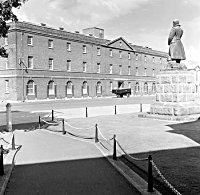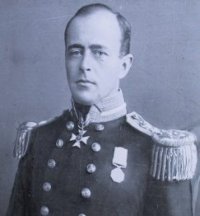Location
Enter the Historic Dockyard by the Victory Gate. The statue is a few yards down College Road on the right.

Memorial (1949)

Portrait

|
CAPTAIN ROBERT FALCON SCOTT RN CVO BORN 6TH JUNE 1868 DIED ABOUT 29 MARCH 1912 DURING HIS RETURN FROM THE SOUTH POLE IN HIS JOURNAL FOUND 8 MONTHS LATER HE WROTE THE GALE IS HOWLING ABOUT US WE ARE WEAK WRITING IS DIFFICULT BUT FOR MY OWN SAKE I DO NOT REGRET THIS JOURNEY WHICH HAS SHOWN THAT ENGLISHMEN CAN ENDURE HARDSHIPS HELP ONE ANOTHER AND MEET DEATH WITH AS GREAT A FORTITUDE AS EVER IN THE PAST WE TOOK RISKS WE KNEW WE TOOK THEM THINGS HAVE COME OUT AGAINST US AND THEREFORE WE HAVE NO CAUSE FOR COMPLAINT BUT BOW TO THE WILL OF PROVIDENCE DETERMINED TO DO OUR BEST TO THE END |
Further Information
Until the 1990s the statue stood about 200m north-west of it's current location, facing towards Storehouse No. 11. It was moved because it stood in the MOD part of the dockyard which is separate from the Historic Dockyard accessible by the public.
For a biography of Scott and the various assessments of his achievements see the entry on Wikipedia.
Manchester Guardian: November 30th 1904
Captain Scott's expedition in the Discovery
No better summary could be given of the result of the Discovery's Expedition than the words of Sir Clements Markham, who has himself been further north than any other Englishman.
Sir Clements has given it as his opinion that the expedition that has just returned from the Antarctic, under command of Captain R.F. Scott, "is the best-conducted and most successful expedition that has ever enteredthe Polar regions, Arctic or Antarctic".
Apart from the scientific observations, the results have been, briefly, the following. On entering Ross Sea the Discovery sailed to the south-western corner and then proceeded along Ross's Ice Barrier, keeping close in shore.
It was thought by Markham that the barrier would eventually turn to the south. Such was not the fact; having ascertained that the ice wall bore north, Scott turned back along the barrier and ran the Discovery into her winter quarters, south of the island on which Mount Erebus is still, as in Ross's time, pouring forth her clouds of smoke.
A series of sledge expeditions were organised which must rank among the most successful on record. While coasting along the barrier Scott had climbed the ice wall, and, making use of his balloon, had made out "parallel lines of undulations to the south".
The first great sledge journey was made almost due south, and Scott attained his "farthest south", reaching the latitude 82deg. 17min. In the following year, two important sledge journeys were performed simultaneously – one to the south of the great barrier, the other in the direction of the magnetic pole.
The records of cold are incredible. A hundred degrees of frost were sometimes registered; one party actually reached a height of 8,900 feet, and were compelled by the force of the wind and the cold to remain in camp no less than six and a half days.
The story of the two visits of the Morning, under Captain Colbeck bringing with it the command, on the seond occasion, to abandon the Discovery, of the steps taken to carry these gloomy orders into execution, of the welcome swell that broke up the ice-field and freed the vessel just as all hope of saving her had been abandoned – all this can now be heard from the lips of the gallant commander who has so well upheld the traditions of his country for intrepidity in Polar exploration.
The Discovery Expedition has so far outdistanced all its predecessors that the Royal Geographical Society have not only awarded their Patron's medal to the commander, but have had a special gold medal prepared, a replica of which in silver is to be given to each member of the company.
